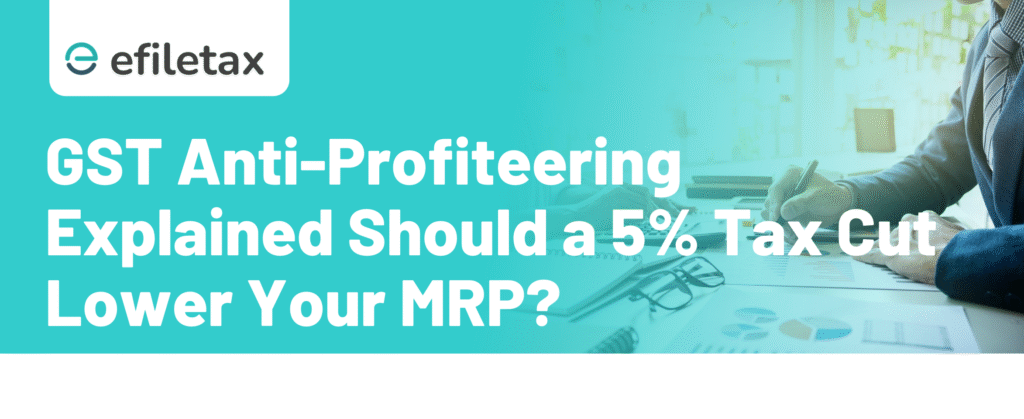
Anti Profiteering under GST How Product Prices Should Vary Based on Tax Rate
The anti profiteering under GST framework was introduced to protect consumers from unfair price hikes after tax rate cuts. When GST rates are reduced, businesses must pass on the benefit to buyers — else, they may face strict penalties. But how should prices really change when GST rates go up or down?
Let’s break it down in a simple, legal, and business-friendly manner.
What Is Anti Profiteering Under GST?
Section 171 of the CGST Act, 2017 clearly lays down:
“Any reduction in rate of tax… or the benefit of input tax credit shall be passed on to the recipient by way of commensurate reduction in prices.”
This means:
If the GST rate drops from 18% to 12%, the final price paid by consumers should decrease proportionately.
If businesses keep prices the same (or raise them), they are violating the anti-profiteering law.
Legal Basis of Anti Profiteering
| Provision | Description |
|---|---|
| Section 171, CGST Act | Mandates passing on benefits of tax rate cuts or ITC to consumers |
| Anti Profiteering Rules, 2017 | Procedural framework under Rule 122–137 |
| National Anti Profiteering Authority (NAA) | Now replaced by the Principal Bench of the GSTAT, as per latest Finance Act amendments |
| CBIC Clarifications | Frequently released through circulars and FAQs on product pricing post rate cuts |
How Should Product Prices Change After GST Rate Cuts?
Let’s understand with an example:
| Particulars | Before GST Rate Cut | After GST Rate Cut (e.g. 18% to 12%) |
|---|---|---|
| Base Price (exclusive of GST) | ₹100 | ₹100 (should ideally reduce) |
| GST @ applicable rate | ₹18 (18%) | ₹12 (12%) |
| Total Price to Customer | ₹118 | ₹112 |
🔸 However, businesses must also review if the base price should go down due to additional input tax credit benefits or other factors.
Key Anti Profiteering Case Laws
- Abbott Healthcare Pvt Ltd v. Union of India – Delhi HC held that anti-profiteering must be applied fairly and based on facts. No arbitrary calculations.
- Kiran Gems Pvt Ltd – NAA ruled that ITC benefits not passed led to profiteering of ₹13 crore.
- Nestle India Ltd – Was directed to reduce prices post-GST rate cut and refund excess charged to consumers.
📚 Source: GST Council, NAA orders, Delhi HC judgments
Expert View: How Businesses Can Stay Compliant
“Keep a clear before-after price comparison sheet every time GST rates change. It protects you in audits.”
– CA S. Prakash, GST Practitioner
Other tips:
- Train billing and finance teams to update prices promptly.
- Use software that maps GST changes to SKUs.
- Avoid blanket price retention after rate cuts.
Penalties for Violating Anti Profiteering Rules
| Non-Compliance | Consequences |
|---|---|
| Not passing on tax reduction | Refund to customers + 18% interest |
| Additional penalty | Up to ₹10,000 or higher |
| Repeat offence | Cancellation of GST registration in extreme cases |
Recent Developments You Should Know
- The NAA has ceased to function; its role is now taken over by GSTAT Principal Bench (post 2024 amendment).
- Businesses are under scanner during rate changes, especially FMCG, pharma, and hospitality.
🔗 Read: Latest CBIC Notifications on GST Rate Cuts
FAQ: Anti Profiteering in GST
Q1. Is anti-profiteering applicable only when tax rates reduce?
Yes, primarily. But it can also apply when businesses gain input tax credit (ITC) benefits they didn’t earlier have.
Q2. What if my product’s base cost has increased due to inflation?
Document it. If costs went up, and not just tax rates down, you may be able to justify not reducing the price fully.
Q3. Who investigates complaints?
Currently, the Director General of Anti-Profiteering (DGAP) investigates and reports to GSTAT.
Summary
Anti profiteering under GST ensures businesses reduce prices when tax rates fall. If not, they face refund orders and penalties. Learn how to stay compliant and protect your business.
Final Thoughts + CTA
Anti profiteering under GST is not just a compliance formality — it’s a customer-rights protection mechanism. Whether you run a small FMCG shop or a D2C brand, you must adjust pricing transparently when tax benefits come your way.